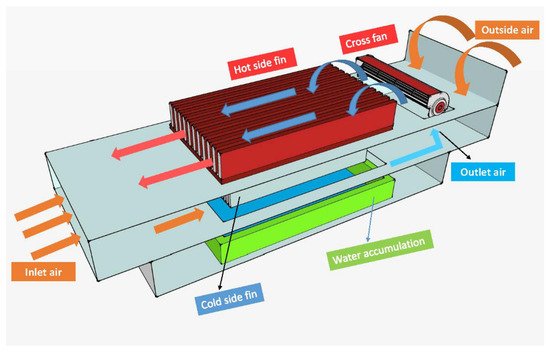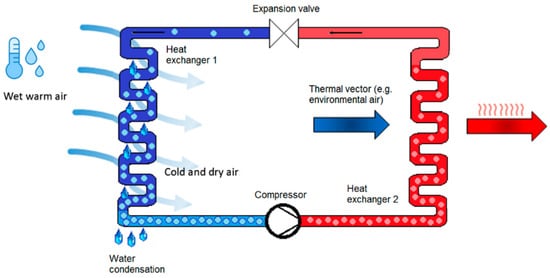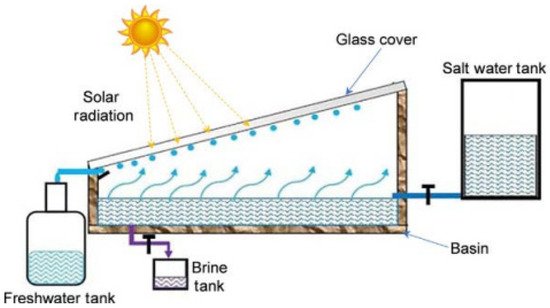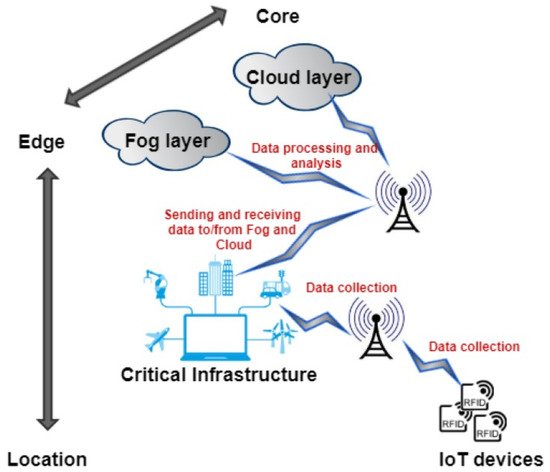The air may be used as a sustainable water supply because it contains over 14,000 km3 of water vapor. There are two methods for extracting water from ambient air. The first approach entails lowering the temperature of humid ambient air to below the dew point. The second method entails sucking water vapor from moist ambient air with a solid adsorbent and a liquid absorbent and then retrieving the water by heating the absorbent and liquefying the evaporated water. Dew water appears to be an easy way to supplement drinking water supplies in a few parts of the world. Small animals and plants are the primary consumers of dew water, as it is necessary for maintaining their activities in a semiarid or dry environment.
1. Introduction
Water vapor is a key component of the atmosphere in atmospheric sciences, meteorology, hydrology, and climate studies. Water vapor has an impact on the Earth’s atmosphere’s energy budget, which causes and maintains atmospheric motions. Solar radiation absorption, nonradiative transport from the Earth’s surface (convection and condensation of water), and thermal radiation absorption all provide energy to the atmosphere
[1]. In most parts of the world, 1 km
2 of atmospheric air contains 10,000–30,000 m
3 of pure water. The patented extraction of water from air (EWA) technique was designed for large-scale water supply, up to 1000 m
3 per day, and is based on the extraction of air humidity into a water stream. The EWA method makes use of air humidity, similar to desalination, which uses an endless free source of salty water. In regions where neither salty water nor infrastructure is available, EWA technology could be a viable alternative for water supply. EWA technology extracts air humidity in three stages: humidity absorption on a solid desiccant, water vaporization at moderate temperatures (65–85 °C), and condensation with a passive condenser connected to a heat pump. EWA technology may offer a reasonable option for water delivery in dry locations, such as the South Mediterranean, as well as countries with contaminated water, such as tropical countries, and those far from seashores where long-pipe systems are not available
[2].
2. Water Extraction Methods
2.1. Air-to-Water Generators (AWGs)
Water extraction from air via reverse-cycle systems is becoming increasingly popular, and a variety of air-to-water generators (AWGs) are now available, all of which claim to be the most efficient
[3]. The atmospheric water generator (AWG) is a possible solution for water scarcity since it converts water vapor to liquid water
[4].
Figure 1 shows the experimental setup of an atmospheric water generator.
The method of water extraction from air is the same for all techniques, whether reverse cycle or not, and it involves driving the condensation of the air vapor content. AWGs with a compression reverse cycle (Figure 2), in particular, force condensation by cooling air to below the dew point. The fundamental benefit of using atmospheric water as a source of drinking water is that no water-transport infrastructure is required; harvesting equipment can be installed practically anywhere (away from the coastline). Dew condensers are divided into two categories: passive and active.
Atmospheric water generators are another name for active condensers (AWGs). With an average airflow of 400 m
3/h and a compressor output of 1000 W, the unique AWG in the figure generates water at a minimum temperature of 10 °C and cools the ambient air to 8 °C below the dew point. It includes two 2 L water tanks that are completely distinct from one another, and schedules can be applied to create water for each container at a specific time. The device is 35 cm in height, 25 cm in length, and 14 cm in width
[3]. Condensation is the primary method by which the AWG converts water vapor to liquid water. It cools moist air to below dew point temperatures, inducing a phase transition from vapor to liquid water across the cooling surfaces, which is subsequently collected
[5][6]. The vapor-compression refrigeration cycle is used in condensation-based AWGs. The ability of the AWG to harvest water from relatively dry air and low temperatures is its most promising feature. Although relative humidity is important to the AWG’s performance, it is less affected by abiotic variables such as sky emissivity, wind speed, and topographic position than passive condensers. As a result, it may be able to operate in a wider range of weather conditions
[5].
Energy was used to examine the performance and economic feasibility of coupling solar liquid desiccant dehumidification with a standard vapor-compression air-conditioning system for the meteorological scenario in Hong Kong. The capacity of the steam compression system of the solar-reinforced air-conditioning system can be reduced from the typical air-conditioning system’s original performance to 19–28 kW. The performance of a standard air-conditioning system was compared to that of a solar desiccant dehumidification system. Due to higher COP resulting from a greater supply of cooled water from more efficient plants, the energy-recovery possibilities due to incorporating the solar desiccant dehumidification system in a conventional air conditioning system are significant for the hot, humid weather in Hong Kong. The hybrid system reduces annual service energy consumption by 6760 kW/h
[7].
The use of a plant intended to function at peak efficiency to produce the best water with the least amount of electricity was presented as a way to extract water from atmospheric air. The study also looked into whether solar energy can be employed in atmospheric water generators (AWGs) as a new source of fresh water. Using HOMER software, a recommended solar AWG unit was conceived, assessed, and designed. The studies revealed that the produced water is safe to drink and that solar-powered AWG technology is technically possible. AWG technology generates consumable water at a lower cost than bottled water and is more environmentally friendly
[8].
AWG technology provides drinkable water at a competitive price compared to bottled water, which is more environmentally and health-friendly. In the program (Cool Pack), return Rankine cycles were established (VCRM). The job required the use of two refrigerant coolants: R134a and R502. Cycle requirements were calculated for autumn, spring, summer, and winter. The results revealed that the optimal mode occurs in autumn, and the optimal refrigerating machine for work in fixed settings with the highest water productivity per day is a VCRM.
This project was based on refrigeration, which is defined as the process of moving heat from one point to another. A compressor, condenser, expansion valve, and evaporator are employed, as shown in
Figure 3 [9].
Figure 3. Block diagram of water extractor
[9].
2.2. Earth-Water Collector
An arrangement consists of columnar and slanted channels over the Earth’s surface that are used to obtain pure water from atmospheric air by cooling humid atmospheric air to a temperature lower than the dew point [10][11]. The amount of gaseous solar radiation absorbers in the atmosphere, such as water vapor and ozone, can also be significant. Downward thermal emission from the atmosphere, which is influenced by clouds and water vapor, as well as upward thermal emission, which is lowered by upward thermal emission, make up the total net radiation that heats the terrestrial surface.
When the brightness of the sun increases, the Earth’s surface becomes dry. The dry surface’s depth differs based on the amount of average rainfall, the depth of the capillary motion, and the soil type in that location. Inside this dry surface, a moist coating is present. This happens due to the interaction between capillary movement and underground water. This capillary action means that this water is lifted to the Earth’s surface by minute slits in the soil. When the sunlight heats the upper surface using solar energy, this water disperses into vapor
[12]. A four-sided figure with a glaze at the slope called the Earth-Water Collector is used. When the upper surface of the Earth is heated by the sun in the form of solar energy, water is evaporated from the surface through water vapor
[13]. This process is known as convection. This collection of water then reaches the ground surface due to gravity as portable fresh water.
Figure 4. Principle of Earth-Water Collector (adapted with permission from Reference
[14], Copyright 2015, Elsevier).
2.3. Absorption–Regeneration Cycle
A conceptual cycle was developed to describe water vapor absorption from atmospheric air, followed by the regeneration process. CaCl
2 was used as a desiccant in this study. The ambient conditions’ influence on the cycle’s operating limits was predicted
[15]. The absorption–regeneration cycle is shown in
Figure 5. These are the four thermal processes:
Figure 5. The absorption–regeneration cycle (adapted with permission from Reference
[15], Copyright 2000, Elsevier).
According to theoretical studies, the limits of weak and strong solution concentrations considerably impact the cycle efficiency value. A cycle efficiency of more than 90% can be achieved for various values of a high solution concentration; however, this value drops when the variation among the strong and weak solution concentrations is minimal. The absorption–regeneration cycle is shown in Figure 5.
2.4. Dew Collection
A plan for large-scale dew collection as a source of fresh water was presented. Using four plastic pipes, the system involves delivering cold seawater (5 °C) from a depth of approximately 500 m and around 5 km from the shore. It then flows through a heat exchanger, condensing 643 m
3 of dew in 24 h. Three wind turbines (each with a capacity of 200 kW) pump seawater from the sea into the area. The system’s technical and economic feasibility was examined. It was determined that the current concept is not economically viable compared to a reverse osmosis facility of comparable capacity
[16]. Dew is formed when moisture in the air condenses and is utilized for drinking and irrigation. Dew-collecting surfaces can benefit from the radiative cooling capabilities of polymer foils. This research was focused on dew development on colored polyethylene foils that have been radioactively cooled. The findings revealed that the volume of collected dew per m
2 is minimal, but large-scale systems can be inexpensive
[17][18]. Dew collection will play an important role in the regions of our planet that are arid
[19].
There are three types of fog collectors: (a) a flat rectangular fog collector, (b) a round rectangular fog collector, and (c) a simple fog collector in the form of a cylinder. A fog collector with two cylinders was put to use. The results revealed that when a larger amount of water was collected on the double-cylinder fog collector, it was possible to achieve an average water production of 0.53 L/m2/day and a maximum water collection of 3.3 L/m
2/day
[20].
Figure 6 shows a flat dew collector and overturned pyramid collector. Experiments to gather passive dew were conducted in a grassland setting. A 1 m
2 flat collector with a 0.39 mm polyethylene foil covering angled at a 30° angle and a second dew collector in the shape of an overturned pyramid were erected. Two models were employed to predict dew collection on the two surfaces: one was a simple surface energy budget model, while the other was an aerodynamic model. According to the statistics, the daily average dew was 0.12–0.03 mm on the grass cover, 0.1–0.06 mm in the flat collector, and 0.15–0.05 mm in the overturned pyramid collector. A fog-water collector system is shown in
Figure 7 [21].
Figure 6. Flat dew collector and overturned pyramid collector.(Adapted with permission from Reference
[19], Copyright 2015, Elsevier).
2.5. Desiccant Systems
Water is extracted from humid air using desiccant materials. A desiccant with a high concentration can absorb moist air at night (absorption phase), and the absorbed water can be removed from the diluted desiccant during the regeneration process by heating. When employing the desiccant method, the regeneration process can be carried out at relatively low temperatures, ranging from 40 to 70 °C, which is ideal for solar stills
[22]. The primary benefit of solar-powered water extraction is its purity, sustainability, and self-sufficiency, as it does not require any infrastructure
[23].
Using ethylene glycol as a liquid desiccant, Hall et al. developed an absorption method for obtaining fresh water from ambient air, followed by recovery in a solar still
[24]. The water retrieved with this method was affected by temperature and humidity. The data were presented in a composition psychometric chart, although the investigation lacked information on the mass of the collected water
[25].
An unorthodox method that captures water from the atmosphere using a solid desiccant was developed. It was also examined whether humid air could be collected by cooling it to a temperature below the dew point using an air-conditioning system
[26]. In a method for extracting humidity from atmospheric air, a desiccant pond was used to absorb humidity from the air and produce a water-rich desiccant. The sun heats the water-rich desiccant, causing the moisture to evaporate and mix with the ambient air, raising the ambient air’s dew point, condensing the vaporized moisture to generate a drinking water condensate, and returning the water-poor desiccant to the desiccant pond. An S-shaped composite material was employed to manufacture water from atmospheric air by soaking it in a physiochemical liquid to absorb humidity from the air
[27]. It was discovered that when the temperature rose, the absorptivity of the surface fell, necessitating a 50-degree angle to absorb humidity. One liter of water might be produced per square meter of composite material.
3. Policy Perspective
Environmental and water resource economic debates are all new topics driving policy decisions on this technology. The best support for AWG system adoption reveals interesting choices, comparable to those seen in intermittent renewable energy sources. On the one hand, a subsidy for the purchase of an AWG or for the price of power may result in social benefits such as cheaper investment in water infrastructure, less environmental harm, and lower health risks. High AWG penetration, on the other hand, may raise overall energy consumption, impair the economy of scale for alternate water resources, and incur economic costs
[28].
This entry is adapted from the peer-reviewed paper 10.3390/en15020421







